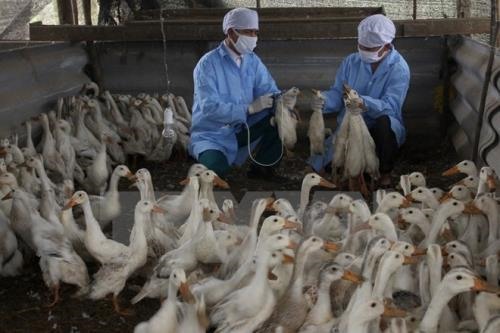 Society
Society

The Mekong Delta province of An Giang has around 4.3 million poultry, 4.2 per cent up from the same time last year, according to its Department of Agriculture and Rural Development.
 |
| Veterinary staff vaccinate ducks against bird flu. – VNA/VNS Photo |
HCM CITY – The Mekong Delta province of An Giang has around 4.3 million poultry, 4.2 per cent up from the same time last year, according to its Department of Agriculture and Rural Development.
It has produced more than 5,780 tonnes of poultry meat and 208 million eggs so far this year, up 7.5 per cent and 2 per cent year-on-year.
The breeding is done mostly by households, with each raising 50 - 100 birds, usually ducks and chickens.
Many farmers also breed 2,000 – 10,000 free-range ducks on their rice fields. This fetches them a large income since they do not have to buy food for the birds, which forage in the fields.
The province’s Agriculture Extension Centre is developing a poultry farming model using advanced breeding techniques in 2017-20.
Breeders are encouraged to use probiotic liners on the ground in their facilities to prevent disease outbreaks and reduce the pollution caused by poultry waste.
Lê Văn Mến, who uses probiotic liners in his chicken farm in Phú Tân District’s Phú Thành Commune, said it helps reduce mortality rates and the bad odour caused by chicken waste compared to traditional methods.
He covers the ground with a 10cm layer of rice husk and spreads probiotics on it, he said.
His chickens reach an average weight of 1.5 kilogrammes by two months of age, he said.
This year the department has stepped up inspection of poultry and treatment of their diseases, provided vaccines and vaccination for the birds and issued licences to farmers for breeding free-range ducks in rice fields.
The province’s veterinary staff regularly inspect poultry and livestock meat sold at markets to ensure food safety.
Slaughter
The An Giang Province People’s Committee has approved a plan to upgrade livestock and poultry slaughterhouses in 2018-25.
The plan envisages building abattoirs with advanced technologies in areas that have large numbers of livestock and birds to ensure the control of diseases, environmental protection and food safety.
In 2018-19 nine of them will be built in Châu Đốc City and Tịnh Biên, Tri Tôn and Thoại Sơn districts whereas in another 10 will be built in the next five years from 2020.
All will have a capacity of slaughtering at least 50 pigs, 20 buffalo and oxen and more than 300 poultry in a day though some may not butcher one or more of these animals. – VNS




